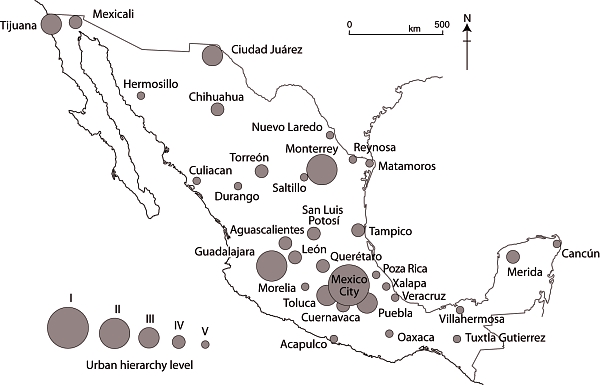Mexico’s urban hierarchy is still very dominated by Mexico City, its primate capital city. Even though the Mexico City urban area (ZMCM) has grown relatively slowly during the past 30 years, by 2000 it had a population of 17.8 million, almost five times larger than Guadalajara, instead of twice as large as expected from the rank size rule.
The concept of urban hierarchy is more complicated than the rank-size rule, which is based solely on population size. Urban hierarchy is based more on the functions provided by urban centers and their relationships with their hinterlands. An urban hierarchy is conceptually similar to an organization chart or layered pyramid. At the top is the largest center, the dominant financial, economic, and often political center of the country. It has the widest range and most complex set of urban functions and services such as international banking, stock exchanges, trade organizations, and major media and communications centers. It is the center of power of the country: the place where the most important decisions are made.
At the second level are a few regional cities that are the centers of power in their region or hinterland. They provide high level services that are not available elsewhere in the region. Such services might include investment banking, an important international airport, as well as sophisticated business, legal and medical centers. At the third level are a larger number of subregional centers which are the focus of economic activity in their subregion. At each succeeding lower level, there are a greater number of centers serving as the economic foci of their smaller hinterlands.
Often a center’s population is a guide to its level in the hierarchy, but not always. Some centers may have a large population, but do not provide a wide range of key economic functions to surrounding areas. For example, Puebla is Mexico’s fourth largest urban area, but does not serve as a real center for a national region because it is so close to Mexico City. In other words, Mexico City is so economically dominant in central Mexico that Puebla has been unable to carve out a substantial hinterland of its own. The same can be said for Toluca, Mexico’s fifth largest urban area.
Tourist centers like Cancún and Acapulco are other examples of cities that have a reduced regional importance despite their relatively large populations. They provide vacation and recreation services for visitors from around the world. However, neither is a state capital, and they are not necessarily the key functional center in their respective regions.
Given their complexity, the specific delineation of urban hierarchies has often been as much art as science. So far, no uniformly accepted, easy to use criteria have been developed for this purpose. Efforts to delineate urban hierarchies have traditionally used information on the range of services provided; financial, communication and transportation flows; as well as a center’s location, its surrounding hinterland, and the distance to competing centers.
Mexico City is at the apex on the Mexican urban hierarchy; Guadalajara and Monterrey are key second level cities. Beyond these three centers, there is less agreement concerning the appropriate levels of other urban centers. Some think there are only two genuine level two cities, while others have argued that Toluca, Tijuana and Ciudad Juárez should also be considered level two cities. There is even less agreement when it comes to specifying cities in levels three and four. The exact delineation of the levels is less important than understanding the basic concepts of urban hierarchy and realizing that a city’s level is related to the range of functions it provides to its surrounding hinterland.
The suggested current urban hierarchy of Mexico (see map) is based on objective and subjective information on the urban center itself, as well as the population in its hinterland and its distance from a competing urban center. This hierarchy is only suggestive. Intermediate levels could be added indicating centers that could arguably be included in either the level above or level below.
The current hierarchy is not static and is very different from the urban system of the Colonial era, or even of the 19th century. The one constant is that Mexico City has always been at the apex of the hierarchy. The positions of individual cities may change drastically with changing economic and political conditions. For example, Guanajuato was once an important level two city, but with the decline of its silver mines, it dropped below level five.
Related posts:
- The geography of Mexico City: index page
- Are Mexico’s large cities growing faster than small cities? (Jun 2011)
- Several Mexican cities rank among the American Cities of the Future (Apr 2013)
- What is the elevation of Mexico’s cities? (Feb 2013)
- The changing climate of Mexico’s urban areas (Dec 2011)
- Mexico’s major metropolitan areas and cities, 2010

Sorry, the comment form is closed at this time.